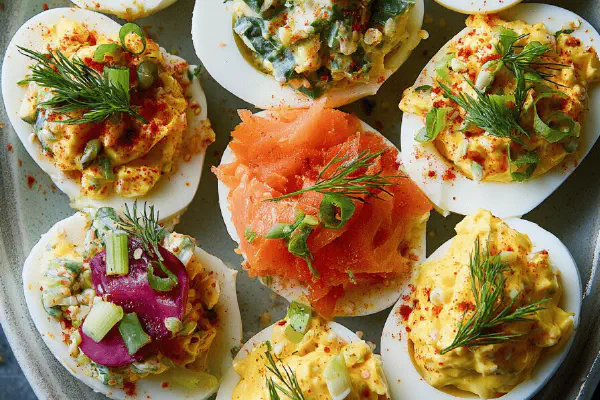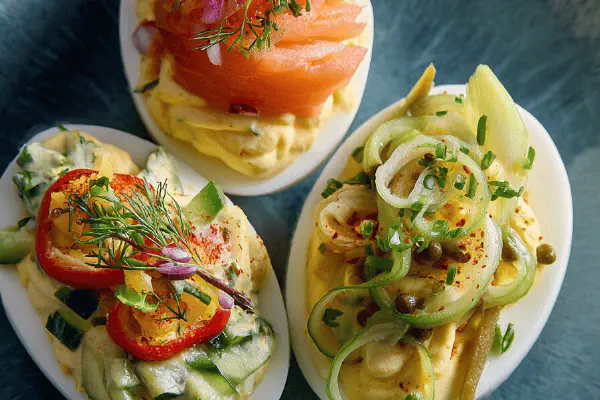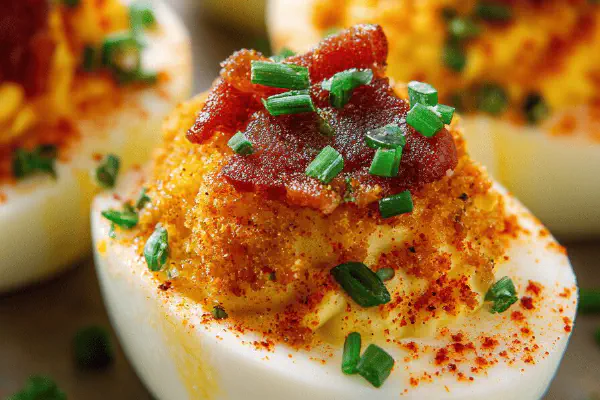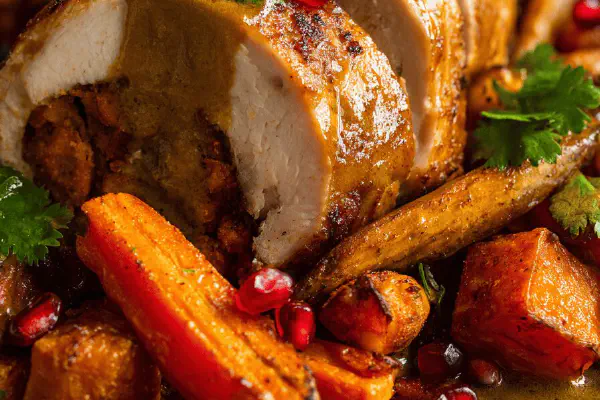Christmas Deviled Eggs Trio
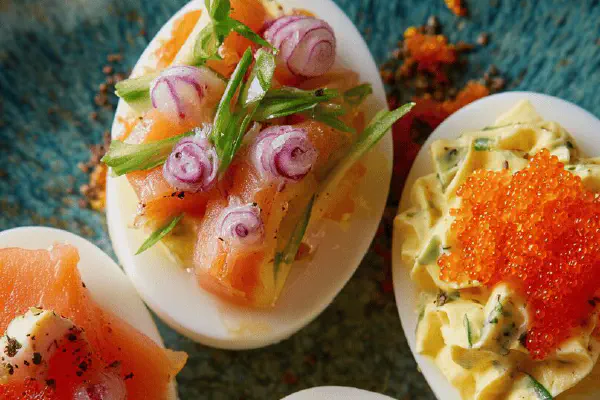
By Emma
Certified Culinary Professional
Ingredients
Deviled eggs like blini
- 10 large fresh eggs
- 50 ml heavy cream 35 percent, lightly whipped
- 5 ml prepared horseradish
- 45 g thin smoked trout strips, rolled into rosettes
- 25 ml lumpfish roe
- 25 ml roughly chopped fresh dill
Deviled eggs like sushi
- 40 ml Japanese mayonnaise
- 5 ml prepared wasabi paste
- 0.5 ml toasted sesame oil
- 1 small Lebanese cucumber, thinly sliced half moons
- 25 ml pickled ginger, pink variety
- 25 ml toasted black or white sesame seeds
Deviled eggs like classic sandwich
- 1 large celery stalk, finely diced
- 10 ml olive oil
- 8 ml white wine vinegar
- 8 ml finely chopped cornichons
- 2 ml chopped fresh tarragon
- 25 ml plain Greek yogurt
- 10 ml light mayonnaise
- 4 ml coarse grain mustard
- 2 ml granulated sugar
About the ingredients
Method
Steam eggs
- Set up a steaming rack inside a wide pot with about an inch of water below the rack. Water mustn’t touch eggs. Boil water vigorously.
- Place eggs gently on rack. Cover pot tightly.
- Steam 7 minutes for creamy whites; yolks softly set but not runny. I found 6 too loose; 8 firmed yolks sharply, losing silkiness. Peek at eggshell color changes—matte spots signal readiness.
- Remove eggs promptly with tongs; plunge into ice water bath at least 12 minutes. Stops cooking abruptly, eases peeling.
- Once cool, gently crack and peel eggs under running water to avoid pockmarks and fragments. Whole halves with smooth whites, please.
Prepare blini style filling
- Whip cream just enough to be soft peaks. Fold in horseradish and pinch salt carefully; it should punch without overwhelming.
- Arrange halved eggs on platter. Each plate gets trout rosettes, dollops of cream horseradish, bit of roe, sprinkle dill.
- Crucial: let guests add cream last to prevent soggy whites. Presentation is rustic, but keep chilled.
Prepare sushi style filling
- Whisk mayo, wasabi, toasted sesame oil; a dash of soy sauce optional for deeper umami, but don't drown flavors.
- Place eggs on serving tray with cucumber slices, pink ginger, sesame seeds.
- Guests spoon wasabi mayo onto yolk for bite-by-bite assembly. Crunch from cucumber, floral sesame, and ginger's sharpness brighten.
Prepare sandwich style filling
- Mix diced celery, olive oil, vinegar, cornichons, tarragon, salt, pepper. Tangy, crisp, herbal.
- In smaller bowl, combine yogurt, mayo, mustard, sugar gently until balanced. Sugar tames mustard heat.
- Lay half eggs, celery mix, and sauce side by side. Forks ready. Good to scoop and pile.
Serve and tips
- Let flavors mingle but don’t let moist ingredients sit too long on whites—avoid gummy texture.
- Try smoked trout instead of salmon for a subtle earthiness.
- If no roe on hand, swap with finely diced cured olives or capers for salty bursts.
- Wasabi can be replaced with mild horseradish but reduce if doubling for sushi eggs to prevent overload.
- Use yolk firmness to guide steaming times; egg freshness affects peel ease and texture. Older eggs peel easier but steam a bit less.
- Serve cold, but bring to room temp 5 minutes before eating to maximize aroma.
- Leftovers? Keep fillings separate and freshly assemble to keep whites crisp.
- Keep kitchen smells balanced—fishy notes from roe, sharpness from wasabi mix well with sweet cream and vinegared celery.
- Final bite experience should have contrast: creamy, crunchy, smoky, tart, and a hint of heat.
- No rushed assembly; this is about layering sensations, each bite a new combo.
- Don’t overfill eggs; balance looks as important as flavor.
- Give people spoons, toothpicks, little napkins. Casual elegance.
- Once tried, I never steam eggs directly in water—steam gives evenly cooked whites with tender yolks every time.
- This method saves me from cracking shells prematurely or using the dreaded rolling method.
- Remember, every stove and egg batch acts differently—trust the visual and tactile cues more than clocks.
Cooking tips
Chef's notes
- 💡 Steam eggs with water just below rack. Don’t let water touch eggs or whites get rubbery. Watch shell texture—not just time. Matte spots or dull sheen mean near done; glossy look still raw. Ice bath immediately after steaming stops carryover heat; peel under running water for neat halves—no ragged edges.
- 💡 Horseradish cream: whip heavy cream to soft peaks only. Overwhipping breaks fat, loses lightness. Fold horseradish gently; salt last to punch carefully. Guests add cream last to keep whites from sogging—important for texture. Smoked trout rosettes look fancy but use any thin smoky fish strips—salmon, trout, or smoked mackerel.
- 💡 Sushi filling blends mayo, wasabi, toasted sesame oil. Use fresh wasabi paste only—old paste turns bitter and sharp. Skip soy if worried about drowning flavors. Crunchy cucumber and pink pickled ginger aren’t garnish only—balance wasabi heat, add fresh texture. Toast sesame seeds fresh to unlock aroma; store dry to avoid rancidity.
- 💡 Classic sandwich filling needs chopped celery, cornichons, and fresh tarragon chopped fine. Vinegar is non-negotiable to cut creaminess; skip or lessen, mix feels flat. Sugar tames mustard’s burn but add slowly—too much dulls sharpness. Light mayo keeps mix light—avoid dense mayo or sandwich will feel heavy.
- 💡 Peeling eggs easy if older eggs avoided but watch yolk doneness. Older eggs peel easier but can overcook yolks faster. Steam times tuned to yolk firmness—six to eight minutes range. Visual cues help: matte spots, shell color shifts. Don’t rush peeling; cracking gently and peeling under water avoids pockmarked whites. Let leftovers and fillings stored separately for best reassemble freshness.
Common questions
How to tell when steamed eggs are done?
Look for matte shell patches, not just time. Glossy means raw inside. Taste texture—seven minutes hits creamy whites, silky yolks. Ice bath crucial; stops cooking. Press lightly to check firmness. Trial batch worth it.
Can I swap smoked trout?
Yes, salmon, mackerel work but change flavor note. For roe, capers or olives chopped work for salty pop. Wasabi swap horseradish cream but cut amounts or sushi eggs get too hot. Toast sesame seeds fresh; old lose aroma fast.
Eggs cracking in steaming?
Use freshest eggs but steam rather than boil. Water below rack, not touching. Cover tightly traps steam evenly. Avoid quick temp shifts. Plunge in ice bath fast after steam ends. Crack gently to avoid ragged whites. Older eggs peel easier but watch yolks.
How best to store leftovers?
Keep fillings separate from eggs. Whites dry, fillings moist—mix before serving again. Store in airtight containers, fridge. Leftover yolks mix fill dry up fast; better to reassemble fresh. Bring to room temp before serving for aroma.
